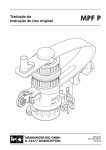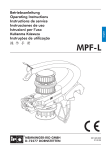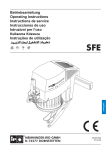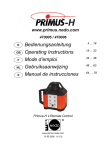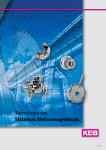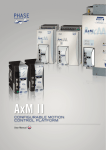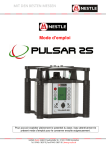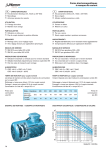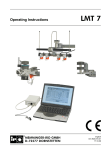Download Operating Instructions
Transcript
Operating Instructions MRA 2 english 027-920-000-01 27.05.09 Introduction / Contents Introduction Congratulations and thank you for choosing a quality product from MEMMINGER IRO. To ensure that you get top performance from this product you should be fully familiar with all its features and functions. This is why we ask you to read this instruction manual carefully before starting to use the product. The manual contains precautions, operating instructions and other useful information about how to make the best use of this product. Keep this manual where it will be readily available for reference. Table of contents Introduction................................................................................................................................................................. 1 Contents...................................................................................................................................................................... 1 Safety........................................................................................................................................................................... 2 Permitted uses............................................................................................................................................................. 2 Safety precautions........................................................................................................................................................ 2 Warranty....................................................................................................................................................................... 2 Disposal........................................................................................................................................................................ 2 Symbols used in this manual........................................................................................................................................ 2 Description.................................................................................................................................................................. 3 Unit components.......................................................................................................................................................... 3 Function........................................................................................................................................................................ 3 Components................................................................................................................................................................. 3 Installation options..................................................................................................................................................... 4 Single motor on one diameter ring with one toothed belt............................................................................................. 4 Single motors on two different diameter rings with two toothed belts........................................................................... 4 Single motors on two same diameter rings with two toothed belts............................................................................... 4 Twin motor on one diameter ring with two toothed belts.............................................................................................. 5 Twin motors on two different diameter rings with four toothed belts............................................................................. 5 Single motor and twin motors on three different diameter rings with five toothed belts............................................... 5 Preparing for installation........................................................................................................................................... 6 Setting the hollow shaft encoder ratio.......................................................................................................................... 6 Setting the toothed belt length...................................................................................................................................... 6 Removing the toothed belts, the tensioning devices and the quality adjustment pulleys............................................. 6 Assembly.................................................................................................................................................................... 7 Fitting the hollow shaft encoder.................................................................................................................................... 7 Fitting the control unit................................................................................................................................................... 8 Fitting the capacitor batteries (optional)....................................................................................................................... 8 Connecting up the step-down transformer (optional)................................................................................................... 8 Fitting the MRA 2 motors.............................................................................................................................................. 9 Fitting the tensioning device....................................................................................................................................... 10 Fitting the toothed belts.............................................................................................................................................. 10 Fitting the GT 3 console............................................................................................................................................. 10 Terminal connection diagram.................................................................................................................................. 11 Control unit................................................................................................................................................................. 11 Electrical connections................................................................................................................................................. 11 Operation................................................................................................................................................................... 12 Layout of GT3 console display................................................................................................................................... 12 Access level menu..................................................................................................................................................... 12 Configuration menu.................................................................................................................................................... 13 Setting the hollow shaft encoder for the set yarn feed rate........................................................................................ 15 Fabric press-off rectification....................................................................................................................................... 16 Device information menu............................................................................................................................................ 16 Fault and status message menu................................................................................................................................ 17 Console menu............................................................................................................................................................ 17 Technical data........................................................................................................................................................... 18 Troubleshooting....................................................................................................................................................... 18 Dimensions............................................................................................................................................................... 19 MRA 2 motor.............................................................................................................................................................. 19 Control unit................................................................................................................................................................. 20 GT3 console............................................................................................................................................................... 21 Hollow shaft encoder.................................................................................................................................................. 21 Declaration of Manufacturer.................................................................................................................................... 22 Safety Permitted uses The MRA 2 system is designed solely for feeding yarn to textile machines. All other uses are not permitted. The manufacturer will not accept any liability for damages resulting from non-permitted uses. The user is liable for damages resulting from non-permitted uses. Safety precautions No special training is required to operate an MRA 2 system. The operator is responsible for ensuring that all instructions regarding the electrical installation, fitting, operation and maintenance of the MRA 2 are implemented. The MRA 2 must only be installed and serviced by qualified electricians working in accordance with current electrical engineering practices and regulations. The MRA 2 has electronic components which are sensitive to interference from electrostatic charges. Before you open the equipment housing, you should take precautions to prevent electrostatic charges. You can discharge any electrostatic charges beforehand by touching an earthed object such as the machine or the earth contact of a socket. The MRA 2 system is designed for operation with a 3 x 400 V AC power supply. The power supply for the MRA 2 must be taken from the circular knitting machine. The power supply to the MRA 2 must be switched on and off from the main switch of the circular knitting machine. This means that the MRA 2 can only be powered up when the machine is powered up. When the machine is turned with the hand lever, the unit must be ready for operation. Before you start any adjustments, even small ones, you must power down the knitting machine. Power up the equipment only after you have completed these adjustments. In the interests of your own safety, please enter all the necessary data on the GT3 console. Before you start any adjustment of the unsprung tensioner device, power down the circular knitting machine. Only use original spare parts and accessories. Warranty Failure to follow the instructions in this manual will void your warranty. The manufacturer will not accept any liability for damages or operating faults resulting from failure to follow the instructions in this manual. Disposal You should dispose of MRA 2 components in compliance with the regulations for the disposal of electrical and electronic components. Symbols used in this manual ! i Caution! This symbol marks important instructions where failure to follow the instructions can cause personal injury or damage to the equipment. Information! This symbol marks useful information which will help you to get the best from the equipment. Description Unit components 1 2 3 4 5 - MRA 2 motors - GT3 console - Control unit - Hollow shaft encoder - Capacitor batteries 3 4 1 2 5 Function The hollow shaft encoder detects and measures machine movements and rotation, translates this measurement into a signal and then sends the signal to the control unit where it is used to control the MRA 2 motor. The GT3 console is used to precision set the yarn feed rate for each individual belt. The yarn feed rate for fabric press-off rectification can be reduced by programming. The MRA 2 motors can run in both directions. This means that the feeder for S and Z yarns can be run with left-handed or right-handed direction of rotation. In the event of a mains power failure, capacitor batteries will continue to power the system until the machine has come to a complete standstill. If a fault occurs during an operating cycle, the machine will be powered down; it will not be possible to restart the machine. MRA 2 motors can be exchanged when required without the need for any reprogramming. Components MRA 2 motor: The MRA 2 motors receive control signals from the control unit and drive the toothed belts at the speed for the set yarn feed rate. In order to handle speed changes, manual operation and starting and stopping, the motor incorporates advanced control technology. The MRA 2 motor incorporates a frequency converter which converts line current into three-phase alternating current with variable frequency. No additional electrical cabinet is required because the converter is already incorporated in the motor. GT3 console: The GT3 console is used to enter all the parameters needed to install and operate the system. Control unit: The control unit is powered from the mains power supply at 3 x 400 V AC. It can power up to six MRA 2 motors. It stores operating parameters and distributes information from the GT3 console and the hollow shaft encoder. The GT3 console is used to enter the yarn feed rate and displays the information about machine movements received from the hollow shaft encoder. This information is processed by the control unit and then transmitted to the MRA 2 motors. Hollow shaft encoder: The hollow shaft encoder is installed on the drive shaft and is connected via a gear box to the machine cylinder. The hollow shaft encoder detects cylinder movements, translates these into pulses and transmits the pulses to the control unit. Capacitor batteries: In the event of a mains power failure, the batteries ensure that the system continues running until the machine has come to a complete standstill; this prevents yarn breakage. Installation options Single motor on one diameter ring with one toothed belt Single motors on two different diameter rings with two toothed belts Single motors on two same diameter rings with two toothed belts Installation options Twin motor on one diameter ring with two toothed belts Twin motors on two different diameter rings with four toothed belts Single motor and twin motors on three different diameter rings with five toothed belts Preparing for installation Setting the hollow shaft encoder ratio Before you fit the MRA 2 system you must set the ratio between the one machine revolution and the revolutions of the knitting machine drive shaft. Example: 10.8 Rotate the machine through one revolution and count the number of revolutions of the quality adjustment pulley. The last revolution of the quality adjustment pulley must coincide with the end of the single machine revolution and should be counted at this point (e.g. 1 machine revolution = 10.8 quality adjustment pulley revolutions) Measure the yarn feed rate per machine revolution. You will need to know the yarn feed rate in order to fine adjust the hollow shaft encoder ratio (see the section Setting the hollow shaft encoder for the set yarn feed rate). 1 Setting the toothed belt length MPF unit on the feeder ring: Toothed belt length = (ring outer diameter + 200 mm) x 3.14 + 500 mm MER unit on the feeder ring: Toothed belt length = (ring outer diameter + 150 mm) x 3.14 + 500 mm Continuous toothed belts are available in sizes from 2 to 16 metres in steps of 200 mm. Measure the belt length required (for example 7100 mm) and then use the next belt length up (7200 mm in this example). Removing the toothed belts, the tensioning devices and the quality adjustment pulleys. Before you fit the MRA 2 you must first remove the toothed belts, the tensioning devices and the quality adjustment pulleys. You can also remove any unnecessary drive shafts and housings. Assembly Fitting the hollow shaft encoder 1 Fix the adapter (2) and the torque bracket (5) to the hollow shaft encoder (4). Fit the encoder support (6) to the torque bracket (5). Slide the hollow shaft encoder (4) onto the drive shaft (8). Screw the screw (1) of the adapter (2) into the keyway on the drive shaft (8). Attach the encoder support (6) to the drive bar/column (9) of the knitting machine. 2 3 4 5 ! 6 Caution! Only the rotor (3) of the hollow shaft encoder (4) should rotate with the drive shaft (8). The torque support (5) should not be bent or kinked. Fit the hollow shaft encoder (4) to the drive shaft (8) and then the quality adjustment pulley (7). 7 8 1 9 Assembly Fitting the control unit Power supply 3 x 400 V AC PE L1 L2 L3 Fit the control unit to the drive bar or column or to the machine foot (see the section Device Components). Connect the MRA 2 motors to the control unit using the motor cables (1.8 or 3.0 metre lengths). Caution! The MRA 2 must only be installed and serviced by qualified electricians working in accordance with current electrical engineering practices and regulations. ! Before you connect or disconnect a motor cable, you must power down the knitting machine. Wait two minutes before unplugging the motor cable. PE: L1: L2: L3: yellow/green black black black Fitting the capacitor batteries (optional) In the event of a mains power failure, knitting machines continue to run on for some time. In the event of a power failure, a MRA 2 system without capacitor batteries will stop the yarn feed immediately and this could cause yarn breakage. On an MRA 2 system with capacitor batteries, the capacitor batteries will continue to power the MRA 2 system until the knitting machine has come to a complete standstill. The number of capacitor batteries required depends on a variety of factors and can only be decided on site. The factors influencing the number of batteries required includes: machine speeds; rotating mass (open wide knitting machines); general condition of the knitting machine; number of MRA 2 motors fitted; motor power required; yarn sensitivity. Power supply from knitting machine 3 x 440 - 585 V, 50/60 Hz 585 V 530 V 485 V 440 V 585 V 530 V 485 V 440 V 585 V 530 V 485 V 440 V Connecting up the step-down transformer (optional) The MRA 2 system operates a rated voltage of 400 V AC. At input voltages greater than 400 V AC and up to 585 V AC, you must fit a step-down transformer between the knitting machine and the control unit. Power supply for the control unit 3 x 400 V, 50/60 Hz Fit the capacitor batteries to the machine foot and connect them to the control unit (see the control unit terminal connection diagram). Fit the step-down transformer in the electrical cabinet or on the machine foot. Assembly Fitting the MRA 2 motors 2 1 Attach the MRA 2 motors (7) to the motor flange (3) with the cheese head screws (5). Adjust the toothed pulley (2) with the cone clamping element (1) to the same height as the tension roller (4) on the drive shaft (6) of the MRA 2 motor (7). 3 4 5 6 7 3 Fix the MRA 2 motors (7) with the motor flange (3) to the feed ring (8) of the machine. 8 Information! In order to prevent vibrations on the feeder ring, the MRA 2 motors should be mounted close to a ring support bracket wherever possible. i 7 i Information! To loosen the cone clamp, unscrew the screws by a few turns. Unscrew and remove two of the screws and then screw them into the two bores by the same amount. This will force the outer cone shell out of the inner shell and thus release the connection. Assembly Fitting the tensioning device Fit the tensioning device to the feeder ring. ! Caution! The MRA 2 should only be used with an unsprung tensioning device. Fitting the toothed belts 1 The motor flange tension roller (1), the MRA 2 motor toothed pulley (2) and the feeder toothed pulley must all be adjusted to the same height. This is ensure that the toothed belts do not run up against the flanks of the tension rollers; belts will be damaged if they run up against the flanks. Do not kink or twist the toothed belts. 2 Fitting the GT 3 console 10 Fit the GT 3 console to the motor flange of the MRA 2 motor. The GT 3 console can also be fitted to a bar. Terminal connection diagram Control unit MRA 2 Motor MRA 2 Motor 1 MRA 2 Motor 4 2 3 4 5 6 7 8 9 10 11 12 13 brown green grey white 1 white green yellow brown 2 3 250 kbit/s Standard GT3 console 14 15 16 5 CAN BUS MRA 2 Motor Motor cable MRA 2 Motor C NO NC +24V CAN H CAN L GND +24V A B GND Hollow shaft encoder 500 kbit/s 6 MRA 2 Motor or capacitor batteries Switching off Power supply 3 x 400 V AC yellow/ green black black black PE L1 L2 L3 Caution! Before you connect or disconnect a motor cable, you must power down the knitting machine. Wait two minutes before unplugging the motor cable. ! Caution! At input voltages greater than 400 V AC and up to 585 V AC, you must fit a step-down transformer (optional) between the knitting machine and the control unit. ! Electrical connections Connect up the MRA 2 system as shown on the terminal connection diagram. Caution! The MRA 2 must only be installed and serviced by qualified electricians working in accordance with current electrical engineering practices and regulations. ! 11 Operation Layout of GT3 console display Device information about the control unit and the MRA 2 motors Configure MRA 2 system Fabric press-off rectification Access level menu Fault or status message Console Exit menu Next page The fields with a yellow background can be set accordingly. i Information! Before you can make any changes You must enter a valid password. Access level menu No access permitted. Access level 1 for knitting machine operators with password “2810”. Users at this level can modify the yarn feed rate per machine revolution, modify the reduction factor in the fabric press-off rectification mode and modify the number of machine revolutions. 12 Access level 2 for machine setters with password “72280”. Users at this level can configure the encoder, the number of teeth on the MRA 2 motor toothed pulley, the feeder direction of rotation and the unit of measurement (metres or inches) used. Enter a valid password. Operation Access level 1 or 2 To leave the menu, use the will be granted. button. Information! If the touch pad is not touched for two minutes, the access level rights will be automatically withdrawn. i Configuration menu 1 Number of teeth on the toothed belt pulley of the MRA 2 motor (1), the default value is 30. Number of hollow shaft encoder revolutions per machine revolution, i.e. the ratio between the machine cylinder and the hollow shaft encoder (2). 3 Information! Enter the ratio on the system before you install the unit (see the section Setting the hollow shaft encoder ratio). i 2 4 Number of pulses per hollow shaft encoder revolution (3). Take the value from the hollow shaft encoder; the default value is 2000. Enter the values using the touchpad (4). Caution! In the interests of your own safety, please enter all the necessary data on the GT3 console. ! 13 Operation 1 2 3 Feeder type selection list (1). Yarn feed rate per feeder revolution (2). Number of teeth on feeder toothed pulley (3). If a feeder is not on the feeder list (1) you must enter the yarn feed rate per feeder revolution (2) and the number of teeth on the toothed pulley (3) using the touchpad. You cannot modify the default settings for the MPF, MER B, MER C and MCF feeders. Set the direction of rotation of the toothed belts during configuration. i 14 Information! The direction of rotation should be the same as that of the knitting machine toothed belts. Operation Product-specific default control parameter settings for service personnel. Setting the hollow shaft encoder for the set yarn feed rate Enter the yarn feed rate per machine revolution set before assembly (see the section Setting the hollow shaft encoder ratio). Start the knitting machine. Measure the actual yarn feed rate per machine revolution. If the actual yarn feed rate does not match the original yarn feed rate, you must adjust the hollow shaft encoder ratio. Start the knitting machine and measure the actual yarn feed rate per machine revolution again. Repeat this procedure until the actual yarn feed rate per machine revolution matches the yarn feed rate measured before installation on the knitting machine. 15 Operation Fabric press-off rectification Start fabric press-off rectification 1 Stop fabric press-off rectification 3 2 Yarn feed rate reduction factor (1). To modify the reduction factor, enter the password “2810”. Number of machine revolutions for which fabric press-off rectification is valid (2). Number of machine revolutions remaining until fabric press-off rectification is automatically finished (3). Fabric press-off rectification mode is active (4). Information! At the end of the fabric press-off rectification cycle the machine will stop. The knitting process can continue. i 4 Device information menu This provides information about the devices installed and their software (Sw) and hardware (Hw) versions. 16 MIF_*** A**** MRA_*** A**** MRA_*** A**** Operation Fault and status message menu When a MRA 2 system fault occurs this is indicated immediately on the GT 3 console display. Console menu Software version of GT3 console (1). Modify the unit of measurement (2) (metres or inches). 1 Change the user language. 2 Setup. Set the display contrast (3). Display adjustment. 3 17 Technical data / Troubleshooting Technical data Line voltage: 3 x 400 V AC ± 10% Line frequency: 45 – 66 Hz Power: 250 VA per MRA 2 motor Max. number of driven feeders: 60 MPF units per belt per MRA 2 motor 24 MER units per belt per MRA 2 motor Max. belt speed: 360 m/min (with 30-tooth drive pulley) 500 m/min (with 40-tooth drive pulley) 576 m/min (with 48-tooth drive pulley) Ambient temperature (operation and storage): 0° to 50° C Weight, GT3 console: 1.1 kg Weight, hollow shaft encoder: 0.9 kg Weight, control unit: 2.3 kg Weight, MRA 2 motor with motor flange: 6.2 kg Troubleshooting Fault after installation Possible cause Solution The MRA 2 motor does not run. Does the motor shaft vibrate for approx. two seconds No. Change the MRA 2 motor or the control unit. when you switch on? Before you connect or disconnect a motor cable, you must power down the knitting machine. Wait two minutes before unplugging the motor cable. Yes. Set the parameters correctly. No. Change the MRA 2 motor or the control unit. The MRA 2 motor does not run. Check if the MRA 2 motor has any torque. Turn the Before you connect or disconnect a motor cable, motor shaft by hand. you must power down the knitting machine. Wait two CAUTION! minutes before unplugging the motor cable. Exercise extreme caution. Yes. Set the parameters correctly. ! The yarn feed rate is too high. The motor speed is too high. Fit a toothed pulley with 48 teeth to the MRA 2 motor. Fault / message during operating cycle Fault message Insufficient Permission Level Possible cause Solution You have entered an invalid password. You have not entered a password. Access rights are withdrawn automatically after two minutes of inactivity. Internal electronic fault Enter a valid password. Fault message Device Status menu 18 Switch the MRA 2 system off and then on again. Dimensions MRA 2 motor 187.5 75 Ø 14 129.5 159 94 19 Dimensions Control unit 20 118 18.5 33 210 151 105 20 Dimensions GT3 console 47 150 200 2.5 8 30 6 6 Hollow shaft encoder Ø30 Ø 17 10.5 25 Ø80 3xM4 111 21 Declaration of Manufacturer Declaration of Manufacturer in accordance with the Machinery Directive (98/37/EC), Annex II B for machinery components in accordance with the Low Voltage Directive (73/23/EC) in accordance with the Electromagnetic Compatibility Directive (89/336/EC) The manufacturer: MEMMINGER-IRO GmbH Jakob-Mutz-Straße 7 D-72280 Dornstetten, Germany hereby certifies that the following product: MRA 2 conforms to the requirements of the above named directives. The following harmonised standards were used: EN ISO 11111 Textile machinery. Safety requirements. EN ISO 12100 Safety of machinery EN 60204-1 Safety of machinery - Electrical equipment of machines Part 1: General requirements EN 61000-4-2 Electromagnetic compatibility (EMC) - Part 4-2: Testing and measurement techniques Electrostatic discharge immunity test EN 61000-4-3 Electromagnetic compatibility (EMC) - Part 4-3: Testing and measurement techniques Radiated, radio-frequency, electromagnetic field immunity test EN 61000-4-4 Electromagnetic compatibility (EMC) - Part 4-4: Testing and measurement techniques Electrical fast transient/burst immunity test EN 61000-4-5 Electromagnetic compatibility (EMC) - Part 4-5: Testing and measurement techniques Surge immunity test EN 61000-6-4 Electromagnetic compatibility (EMC) - Part 6-4: Generic standards Emission standard for industrial environments The machine components are complete with original operating manuals and technical documentation. This machine may only be operated when it is certified that its components conform to the requirements of the machinery directives. Dornstetten, 11.12.2006 22 M. Kleindorp, Company Management MEMMINGER-IRO GmbH Postfach 1240 D-72277 DORNSTETTEN Jakob-Mutz-Straße 7 D-72280 DORNSTETTEN Tel.: (0)7443-281-0 Fax: (0)7443-281-101 E-Mail: [email protected] Internet: www.memminger-iro.de © 2006 MEMMINGER-IRO GmbH / D-72277 DORNSTETTEN Nachdruck, auch auszugsweise, nur mit schriftlicher Genehmigung der MEMMINGER-IRO GmbH. Änderungen vorbehalten. Reprint, even in extracts, shall require the written approval of MEMMINGER-IRO GmbH. Subject to modifications.


























